Chinese estimates of the size of North Korea’s nuclear arsenal have increased in recent years, and are now higher than American estimates, The Wall Street Journal reported (Google link) Wednesday.
The latest Chinese estimates, relayed in a closed-door meeting with U.S. nuclear specialists, showed that North Korea may already have 20 warheads, as well as the capability of producing enough weapons-grade uranium to double its arsenal by next year, according to people briefed on the matter.
A well-stocked nuclear armory in North Korea ramps up security fears in Japan and South Korea, neighboring U.S. allies that could seek their own nuclear weapons in defense. Washington has mutual defense treaties with Seoul and Tokyo, which mean an attack on South Korea or Japan is regarded as an attack on the U.S.
“I’m concerned that by 20, they actually have a nuclear arsenal,” said Siegfried Hecker, a Stanford University professor and former head of the Los Alamos National Laboratory, who attended the closed-door meeting in February. “The more they believe they have a fully functional nuclear arsenal and deterrent, the more difficult it’s going to be to walk them back from that.”
The Journal cited Adm. William Gortney, head of U.S. Northern Command, who said that defense officials believe that North Korea has the capability of mounting nuclear warheads on the KN-08, an intercontinental ballistic missile with a range of 5,600 miles—long enough to reach California. In addition to the potential direct threat to the United States, the growing North Korean nuclear threat poses a proliferation threat, as the U.S.’s allies in the region, South Korea and Japan, may seek their own nuclear weapons to deter North Korea.
North Korea came to a nuclear agreement with the United States in 1994 that was intended to halt its nuclear development, but it hasn’t prevented the rogue nation from developing nuclear weapons. In 2002, North Korea expelled nuclear inspectors from the International Atomic Energy Agency out of the country, and announced in 2003 that it was withdrawing from the Nuclear Nonproliferation Treaty. North Korea has allowed and expelled nuclear inspectors to and from the country several times. In 2006, 2009, and 2013, North Korea detonated test nuclear bombs. Shortly before the 2009 test explosion, North Korea expelled nuclear inspectors in reaction to a United Nations condemnation of a missile launch.
While North Korea’s first two nuclear detonations were of bombs made from plutonium, there is uncertainty what kind of fuel was used for the third in 2013. This uncertainty has raised concerns that Iran may have participated in developing the bomb.
North Korea’s development of a nuclear weapon after coming to an agreement that was supposed to prevent that outcome has prompted some to draw parallels to the current negotiations with Iran. “We saw how North Korea was able to game this whole process. I wouldn’t be surprised if Iran had its hands on the same playbook,” House Foreign Affairs Committee Chair Rep. Ed Royce (R – Calif.) told the Journal.
[Photo: CNN / YouTube ]




